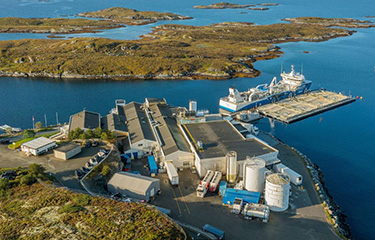Mowi shifts processing capacity, trials AI for sea lice detection

The world’s largest salmon farming company is shifting its processing capacity and trialing an artificial intelligence solution for sea lice detection.
Mowi is selling its 7,500-square-meter salmon slaughterhouse, which sits on a 55,000-square-meter plot in Ulvøya, Norway, in Hitra municipality, as it moves to a new facility on nearby Jøsnøya. The facility, which is being offered with equipment included, was built in 1972 and has undergone several additions. It is available for occupation beginning in spring 2024, according to a Finn real estate listing.
Separately, Mowi has added two production lines at its production plant in Rosyth, U.K., as well as crate destackers, case packers, and a palletizing robot from Lan Handling Technologies to "significantly boost" secondary packaging capacity to 120 products per minute on each line. The facility processes farmed salmon from full fish to fillets and smoked salmon, according to Mowi Head of U.K. Operations Gary Peterson.
"Working with Lan feels like a partnership. We are sharing ideas to innovate," Peterson told the Dunfermline Press. "I haven’t received any complaints from my colleagues regarding the machines, which confirms that everything is operating smoothly."
Peterson said the improvements will help meet increasing market demand and save on labor.
Also in the U.K., Mowi has been involved in a project led by Aberdeen University and the Oban-based Scottish Association for Marine Science to trial the use of artificial intelligence in sea lice detection at its net-pen salmon farms.
Using holographic camera technology from Hi-Z 3D in conjunction with AI-based automated image identification technology, the system is designed to help identify the natural presence and abundance of sea lice in fish farms in a faster and more accurate manner. Currently, the most common way of testing for the parasite is to collect water samples to be analyzed in a lab under a microscope, which can take several days to return results, according to the Sustainable Aquaculture Innovation Centre.
The project recently received GBP 538,000 (USD 662,000, EUR 624,000) in funding from the U.K. Seafood Innovation Fund and the SAIC.
The system will be trained with thousands of holographic images of sea lice, according to University of Abredeen School of Engineering Researcher Thangavel Thevar.
“The type of camera being used in this project was first developed for the identification of marine organisms and microparticles in the ocean. However, as it provides an accurate reflection of the different species present in the water, we saw an opportunity for the tool to be used to support the aquaculture sector with fish health management,” Thevar said. “The holographic imaging technology will be supported by AI and machine learning, which will help with the identification and cut processing time significantly. A major element of the project is to train the tool to recognize sea lice over other [plankton] species, and the images gathered over the next 18 months will help us to create the baseline for future analysis.”
SAMS is opening a new hatchery specifically dedicated to growing sea lice for the project, and will be supplying digitally labeled holographs, using a newly developed camera that can instantaneously record a volume of water and extract high-resolution images of the various particles present in the water.
“Sea lice are a concern for the aquaculture sector and regulators and one of the first steps to managing them is to identify whether they are present in the water,” SAMS Aquaculture Researcher Helena Reinardy said. “Currently, samples are taken using a zooplankton net which requires a lot of time and specialist expertise to pick through all the abundance of zooplankton to find and identify sea lice larvae. This new system could provide an opportunity for more regular and accurate monitoring to provide an early indication of potential sea lice risks and, by the end of this project, we hope to be ready for trialing the system at sea.”
In the future, the system could be used by seafood producers as an early indication of sea lice at the larval stage, as well as being integrated into management strategies, according to SAIC CEO Heather Jones.
“We have fantastic technology coming out of Scotland’s universities and it is exciting to see how new data-led techniques could support aquaculture to thrive,” Jones said. “This system could become a valuable tool in our armory for sustainably tackling the challenge of sea lice on salmon farms. Collaboration is a crucial element of its development, and this project could be transformational for fish health management, delivering economic value for the sector while minimizing its environmental footprint.”
Additionally, Mowi is trialing the Harbor Fence, a patented device from Harbor AS that uses small electromagnetic fields to combat sea lice infestations. A trial is taking place at Mowi's Rogne farming site in Norway’s Møre and Romsdal region, assessing the technology's effectiveness and impact on fish health, according to Compsmag.
Photo courtesy of Mowi






Share